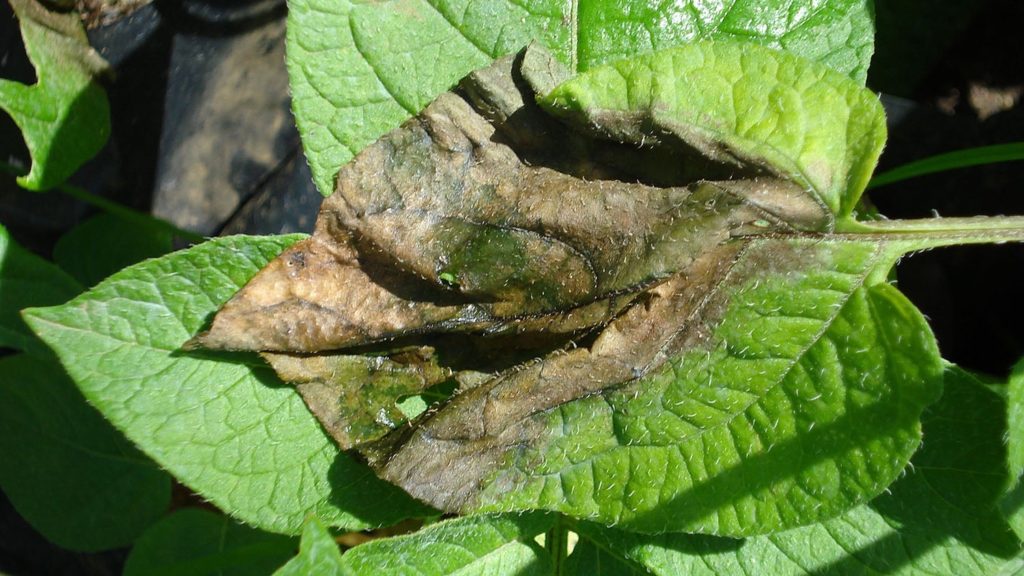
Wild potato relatives help fight late blight
Late blight, caused by Phytophthora infestans, is one of the most threatening pathogenic diseases in potatoes. It is estimated that losses due to late blight cost global potato farmers an estimated $6.7 billion annually. Globally, scientists believe wild potato relatives hold the key to unlocking new sources of resistance. In the United Kingdom, U.S. and sub-Sahara Africa, scientists integrate resistance genes from wild relatives into regionally popular varieties, which help to increase uptake.
UK researchers identify new source of resistance
Phytophthora infestans is a tricky pathogen. It has an uncanny ability to mutate into new variants, and oftentimes those variants easily overcome the genes that are there to protect the potato variety against infection. Moreover, single resistance genes have limited resistance to the range of pathogen variants, which means they can also be overcome quite quickly.
Researcher Jonathan Jones and his team at the Sainsbury Laboratory, an independent research institute in the UK, found a new source of resistance while exploring a range of wild Solanum plants related to potato. An ancestor of a wild variety widely found in the UK, Solanum americanum, contains the resistant gene Rpi-amr1 and its many variants. Interestingly, despite the fact that each Rpi-amr1 variant’s sequence differs by as much as 10%, they all enable detection of the two virulence proteins associated with late blight. In fact, Rpi-amr1 confers resistance against all tested 19 blight strains.
Jones and his colleagues have combined the Rpi-amr1 resistance gene with two other resistance genes (Rpi-amr3 and Rpi-vnt1) in the commercially popular variety Maris Piper. The resulting lines show immunity to a wide variety of blight races. Jones is thrilled to finally see the team’s work in print, calling the new gene “one of the best resistance genes in our armoury against late blight.”
ARS researchers test wild potato species for late blight resistance
A team of Agricultural Research Service (ARS) scientists evaluated wild potato ancestors in a search for new sources of resistance to late blight. In laboratory trials, the scientists exposed the leaves of 72 wild potato species to late blight pathogen spores. Led by ARS Vegetable Crops Research Unit plant geneticist Dennis Halterman, and in collaboration with ARS scientist Shelley Jansky and ARS research associate Hari Karki, the aim of the research project was to identify new sources of resistance that could be used to bolster innate control against the virulent pathogen that causes late blight. Halterman said that once identified, the goal is to transfer the resistance to cultivated potato varieties so farmers can grow healthy crops using fewer pesticides.
Of the 72 species evaluated, 12 showed previously undocumented, high levels of leaf resistance. Halterman hopes that a combination of modern tools — marker assisted selection, genome mapping, and the ability to clone — will enable them to develop new varieties faster than the standard 10-15 year period.
Five of the 12 species can be used in potato breeding programs immediately: S. agrimonofolium, S. albornozii, S. chomatophilum, S. hypacrarthrum, and S. piurae.
Africa
Potatoes are cultivated in 14 sub-Sahara African countries. Cropland comprises 1.7 million hectares, and provides food and income for some 7 million farmers. Late blight is especially devastating in this region of the world, as the average farmer works a one quarter-hectare plot. Losses of 30-60% are common in sub-Saharan Africa.
In a paper on defeating late blight in sub-Saharan Africa, the authors calculated the cost of fungicides, overall losses and potato prices per tonne to get an idea of overall losses. Late blight, they said, costs sub-Saharan African farmers $300 to $800 million each year.
Authored by University of Nebraska-Lincoln research professor Richard Goodman, Marc Ghislain, global leader of the biotechnology research program, International Potato Center, and Alex Barekye, director of research, Kachwekano Zonal Agricultural Research and Development Institute, the paper espouses the potential of the 3R potato. Developed by the International Potato Center (CIP), the new variety includes three genes that recognize a broad spectrum of P. infestans strains.
Working in collaboration with the National Agriculture Research Organization (NARO), CIP conducted confined field trials in Uganda. According to Goodman and his co-authors, all 3R potato transgenic events grown were unaffected by late blight disease even in cases where fungicides were not used. In the same trial, the non-transgenic varieties were completely devastated. In Uganda, the 3R genes were added to the prominent variety Victoria. The variety performed well in over a dozen field trials without fungicides, conducted over the last five years.
3R potatoes have also been developed and field tested in The Netherlands, Belgium, Ireland, the United Kingdom, Sweden, the U.S., Indonesia and Bangladesh. In all locations, the transgenic potatoes were grown without fungicides. All crops yielded well.














